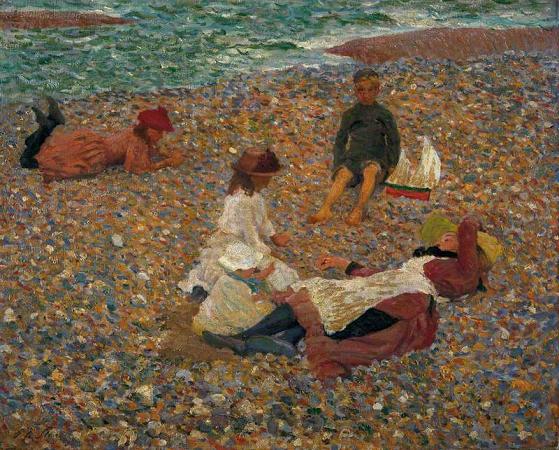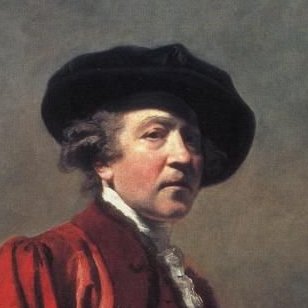Augustus John (1878 - 1961). Augustus Edwin John was a Welsh painter, draughtsman, and etcher. For a short time around 1910, he was an important exponent of Post-Impressionism in the United Kingdom. He was the brother of the painter Gwen John. Born in Tenby, Pembrokeshire, John was the younger son and third of four children. His father was Edwin William John, a Welsh solicitor; his mother, Augusta Smith from a long line of Sussex master plumbers, died young when he was six, but not before inculcating a love of drawing in both Augustus and his older sister Gwen. At the age of seventeen he briefly attended the Tenby School of Art, then left Wales for London, studying at the Slade School of Art, University College London. He became the star pupil of drawing teacher Henry Tonks and even before his graduation he was considered the most talented draughtsman of his generation. His sister, Gwen was with him at the Slade and became an important artist in her own right. In 1897, John hit submerged rocks diving into the sea at Tenby, suffering a serious head injury; the lengthy convalescence that followed seems to have stimulated his adventurous spirit and accelerated his artistic growth. In 1898, he won the Slade Prize with Moses and the Brazen Serpent. John afterward studied independently in Paris where he seems to have been influenced by Puvis de Chavannes. The need to support Ida Nettleship, whom he married in 1901, led him to accept a post teaching art at the University of Liverpool. Augustus John and his student James Dickson Innes spent two years painting in the Arenig valley around 1910, especially the mountain Arenig Fawr. In 2011 this period was made the subject of a BBC documentary titled The Mountain That Had to Be Painted. Some time in 1910, John fell in love with the town of Martigues, in Provence, located halfway between Arles and Marseilles, and first seen from a train en route to Italy. John wrote that Provence had been for years the goal of my dreams and Martigues was the town for which he felt the greatest affection. With a feeling that I was going to find what I was seeking, an anchorage at last, I returned from Marseilles, and, changing at Pas des Lanciers, took the little railway which leads to Martigues. On arriving my premonition proved correct: there was no need to seek further. The connection with Provence continued until 1928, by which time John felt the town had lost its simple charm, and he sold his home there. He was, throughout his life, particularly interested in the Romani people, and sought them out on his frequent travels around the United Kingdom and Europe. For a time, shortly after his marriage, he and his family, which included his wife Ida, mistress Dorothy McNeill, and John's children by both women, travelled in a caravan, in gypsy fashion. Later on he became the President of the Gypsy Lore Society, a position he held from 1937 until his death in 1961. During World War I, he was attached to the Canadian forces as a war artist and made a number of memorable portraits of Canadian infantrymen. The end result was to have been a huge mural for Lord Beaverbrook and the sketches and cartoon for this suggest that it might have become his greatest large-scale work. However, like so many of his monumental conceptions, it was never completed. As a war artist, he was allowed to keep his facial hair and therefore, he and King George V were the only Army officers in the Allied forces to have a beard, apart from pioneer sergeants and those who were allowed unshaven for medical reasons. After two months in France he was sent home in disgrace after taking part in a brawl. Lord Beaverbrook, whose intervention saved John from a court-martial, sent him back to France where he produced studies for a proposed Canadian War Memorial picture, although the only major work to result from the experience was Fraternity. In 2011, the Duke and Duchess of Cambridge finally unveiled this mural at the Canadian War Museum in Ottawa. This unfinished painting, The Canadians Opposite Lens, is 12 feet high by 40 feet long. Although known early in the century for his drawings and etchings, the bulk of John's later work consisted of portraits. Those of his two wives and his children were regarded as among his best. He was known for the psychological insight of his portraits, many of which were considered cruel for the truth of the depiction. Lord Leverhulme was so upset with his portrait that he cut out the head but when the remainder of the picture was returned by error to John there was an international outcry over the desecration. By the 1920s John was Britain's leading portrait painter.
more...









